UPDATED
Lava spewing again from Canary Islands volcano, airport remains closedGAIA LIVES PELE VOCIFERATES
Issued on: 28/09/2021 -
Text by: NEWS WIRES|
Video by: Fraser JACKSON
A volcano began spewing out ash again Monday after a brief lull in the Canary Islands, where coastal residents are confined to their homes over fears of toxic gases when the lava hits the sea.
La Cumbre Vieja, which straddles a southern ridge in La Palma in the Atlantic archipelago, erupted on September 19, spewing out rivers of lava that have slowly crept towards the sea.
But on Monday morning, the lava and ash flow had stopped, and the week-long rumble of the eruption faded to silence, before resuming its activity several hours later, an AFP correspondent at the scene said.
Smoke had continued to emerge from the top during the lull.
"In the last hours, the volcanic tremor has almost disappeared, as well as the explosive strombolian activity," tweeted Involcan volcanology institute, using the scientific term for a mix of explosions and lava flow.
"Volcanic activity in La Palma has reduced significantly in the last few hours," Madrid's Institute of Geosciences tweeted.
"We must be very vigilant about how it evolves because the scenario can change quickly."
Several hours later, the volcano started pumping out ash again.
Fits and starts
Speaking to AFP after the resumption, Involcan spokesman David Calvo said it was "just ash, for the time being". La Cumbre Vieja had been switching between "explosive episodes and lulls for quite a while", he added.
Overnight, 300 residents living in coastal areas were ordered to stay at home to avoid harm from the release of toxic gases when the lava finally reaches the sea, the regional government said.
"The population must follow the instructions of the authorities and remain at home, with doors and windows closed," it said.
The lava, moving very slowly, is currently between 800 and 1,000 metres (around half a mile) away from the shore, it said. An evacuation order affecting four areas is in place around Tazacorte, where it is expected to enter the sea.
Officials have also set up an exclusion zone to head off curious onlookers.
Experts say the entry of lava into the seawater will send clouds of toxic gas into the air, causing explosions and a fragmentation of the molten rock like gunshots.
"Inhalation or contact with acid gases and liquids can irritate the skin, eyes and respiratory tract, and may cause breathing difficulties, especially in people with pre-existing respiratory diseases," Involcan warned.
Air traffic disrupted
The molten rock has so far scorched its way across more than 235 hectares of land, burning up many banana plantations, devoured 513 properties and destroyed nearly 20 kilometres of road, the European Union's Copernicus Earth Observation Programme said.
And eruption has so far force more than 6,000 people from their homes, although 160 were allowed to return home on Sunday.
The authorities also said clouds of ash from the volcano had started to affect areas on the eastern side of the island.
At La Palma's airport, where air traffic was halted on Saturday for 24 hours due to the ash, local airline Binter said it had been unable to resume flights.
"We have halted our La Palma operations again after trying to make a first flight today and finding conditions were not safe enough," tweeted the airline, which is based in the Canary Islands, saying it would try again on Tuesday.
(AFP)
Lava from Spanish island volcano rolls slowly toward the sea
by Daniel Roca and Barry Hatton
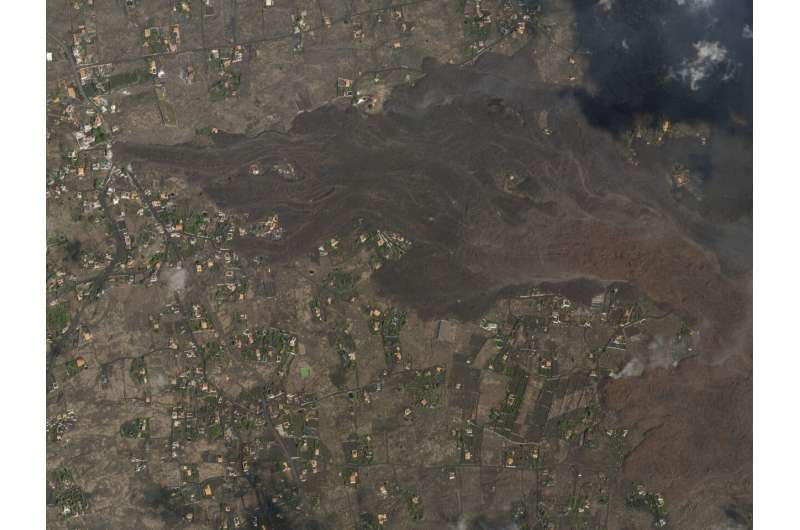
by Daniel Roca and Barry Hatton

In this Saturday, Sept. 25, 2021 satellite photo from Planet Labs Inc. lava and ash from a volcano on the Canary island of La Palma, Spain can be seen. A Spanish island volcano that has buried more than 500 buildings and displaced over 6,000 people since last week lessened its activity on Monday, although scientists warned that it was too early to declare the eruption phase finished and authorities ordered residents to stay indoors to avoid the unhealthy fumes from lava meeting sea waters. Credit: Planet Labs Inc. via AP
Lava flowing from a volcano in Spain's Canary Islands picked up its pace on its way to the sea Tuesday, but scientists said it was impossible to estimate when the black-and-red stream of molten rock would reach the shore.
Authorities said the lava had moved on the island of La Palma to within 800 meters (875 yards) of the Atlantic Ocean as of Tuesday morning, nine days after the volcano's eruption. When it eventually meets sea water, the lava could trigger explosions and the release of toxic gas.
By the afternoon, officials said various factors dictated the unpredictable speed of the lava flow, including its departure from a path over an earlier flow that had hardened. The river of cooled lava had helped the moving flow slide along.
"The lava cools down as time passes and it meets uneven ground, which slows it down," said Miguel Ángel Morcuende, technical director of the Canary Islands emergency volcano response department. "And if it comes off the highway it was going along, that slows it even more because it spreads out wider."
A small hill and a built-up area also stood in the lava's way, and the shore area is flatter than the hills the lava has been flowing down.
For days, officials have nervously awaited the time when lava from the Sept. 19 eruption reaches the Atlantic, but the volcano has been erratic. After calming down on Monday, the volcano became more explosive again overnight.
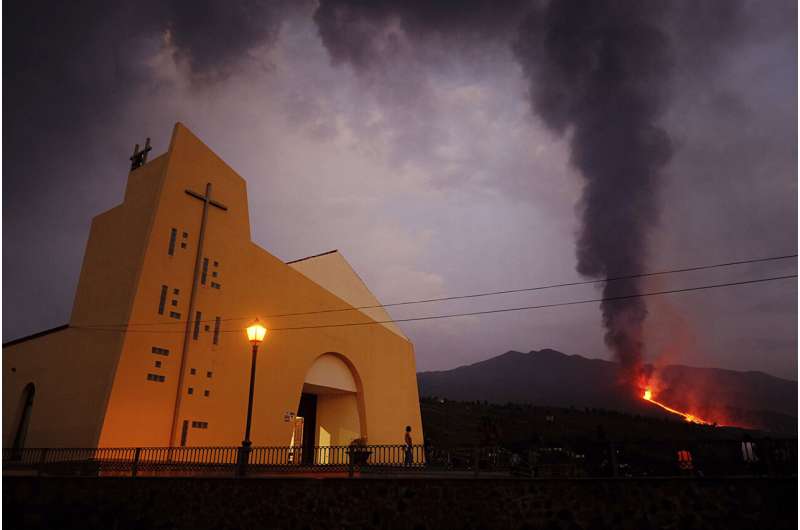 Lava flows from a volcano on the Canary island of La Palma, Spain on Monday Sept. 27, 2021. A Spanish island volcano that has buried more than 500 buildings and displaced over 6,000 people since last week lessened its activity on Monday, although scientists warned that it was too early to declare the eruption phase finished and authorities ordered residents to stay indoors to avoid the unhealthy fumes from lava meeting sea waters. Credit: AP Photo/Daniel Roca
Lava flows from a volcano on the Canary island of La Palma, Spain on Monday Sept. 27, 2021. A Spanish island volcano that has buried more than 500 buildings and displaced over 6,000 people since last week lessened its activity on Monday, although scientists warned that it was too early to declare the eruption phase finished and authorities ordered residents to stay indoors to avoid the unhealthy fumes from lava meeting sea waters. Credit: AP Photo/Daniel Roca
Authorities said they don't expect the slow-moving lava to create a large disruption on the coast. But Eugenio Fraile, a researcher at the Spanish Oceanography Institute, told Cadena Ser radio that only scientists wearing protective gear will be inside a security perimeter when the flow hits the ocean.
The National Geographic Institute detected six earthquakes Tuesday in the area of the eruption, with the strongest measured at magnitude 3.3.
La Palma, home to about 85,000 people, is part of the volcanic Canary Islands, an archipelago off northwest Africa. The island is roughly 35 kilometers (22 miles) long and 20 kilometers (12 miles) wide at its broadest point.
Lava from the eruption has devoured everything in its path, destroying 589 buildings and 21 kilometers (13 miles) of roads on La Palma. The lava now covers 258 hectares (637 acres), mostly farmland, according to a European Union satellite monitoring agency.
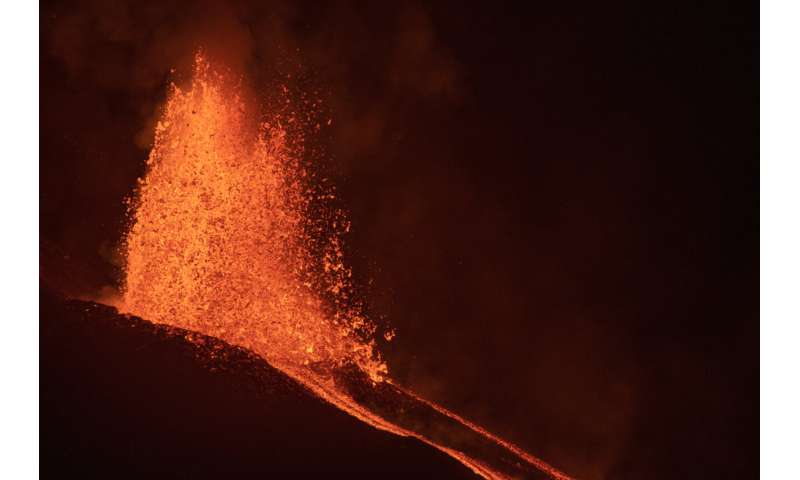
Lava flowing from a volcano in Spain's Canary Islands picked up its pace on its way to the sea Tuesday, but scientists said it was impossible to estimate when the black-and-red stream of molten rock would reach the shore.
Authorities said the lava had moved on the island of La Palma to within 800 meters (875 yards) of the Atlantic Ocean as of Tuesday morning, nine days after the volcano's eruption. When it eventually meets sea water, the lava could trigger explosions and the release of toxic gas.
By the afternoon, officials said various factors dictated the unpredictable speed of the lava flow, including its departure from a path over an earlier flow that had hardened. The river of cooled lava had helped the moving flow slide along.
"The lava cools down as time passes and it meets uneven ground, which slows it down," said Miguel Ángel Morcuende, technical director of the Canary Islands emergency volcano response department. "And if it comes off the highway it was going along, that slows it even more because it spreads out wider."
A small hill and a built-up area also stood in the lava's way, and the shore area is flatter than the hills the lava has been flowing down.
For days, officials have nervously awaited the time when lava from the Sept. 19 eruption reaches the Atlantic, but the volcano has been erratic. After calming down on Monday, the volcano became more explosive again overnight.
 Lava flows from a volcano on the Canary island of La Palma, Spain on Monday Sept. 27, 2021. A Spanish island volcano that has buried more than 500 buildings and displaced over 6,000 people since last week lessened its activity on Monday, although scientists warned that it was too early to declare the eruption phase finished and authorities ordered residents to stay indoors to avoid the unhealthy fumes from lava meeting sea waters. Credit: AP Photo/Daniel Roca
Lava flows from a volcano on the Canary island of La Palma, Spain on Monday Sept. 27, 2021. A Spanish island volcano that has buried more than 500 buildings and displaced over 6,000 people since last week lessened its activity on Monday, although scientists warned that it was too early to declare the eruption phase finished and authorities ordered residents to stay indoors to avoid the unhealthy fumes from lava meeting sea waters. Credit: AP Photo/Daniel RocaAuthorities said they don't expect the slow-moving lava to create a large disruption on the coast. But Eugenio Fraile, a researcher at the Spanish Oceanography Institute, told Cadena Ser radio that only scientists wearing protective gear will be inside a security perimeter when the flow hits the ocean.
The National Geographic Institute detected six earthquakes Tuesday in the area of the eruption, with the strongest measured at magnitude 3.3.
La Palma, home to about 85,000 people, is part of the volcanic Canary Islands, an archipelago off northwest Africa. The island is roughly 35 kilometers (22 miles) long and 20 kilometers (12 miles) wide at its broadest point.
Lava from the eruption has devoured everything in its path, destroying 589 buildings and 21 kilometers (13 miles) of roads on La Palma. The lava now covers 258 hectares (637 acres), mostly farmland, according to a European Union satellite monitoring agency.

Lava flows from a volcano on the Canary island of La Palma, Spain in the early hours of Tuesday Sept. 28, 2021. A Spanish island volcano that has buried more than 500 buildings and displaced over 6,000 people since last week lessened its activity on Monday, although scientists warned that it was too early to declare the eruption phase finished and authorities ordered residents to stay indoors to avoid the unhealthy fumes from lava meeting sea waters. Credit: AP Photo/Saul Santos
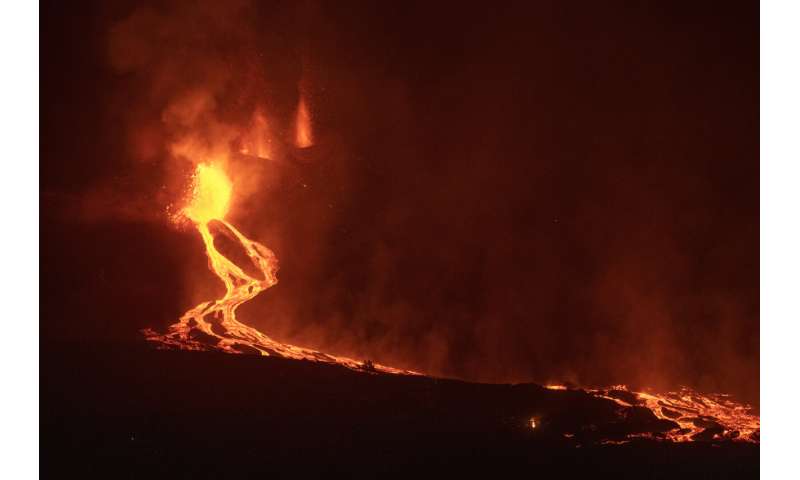

Lava flows from a volcano on the Canary island of La Palma, Spain in the early hours of Tuesday Sept. 28, 2021. A Spanish island volcano that has buried more than 500 buildings and displaced over 6,000 people since last week lessened its activity on Monday, although scientists warned that it was too early to declare the eruption phase finished and authorities ordered residents to stay indoors to avoid the unhealthy fumes from lava meeting sea waters. Credit: AP Photo/Saul Santos
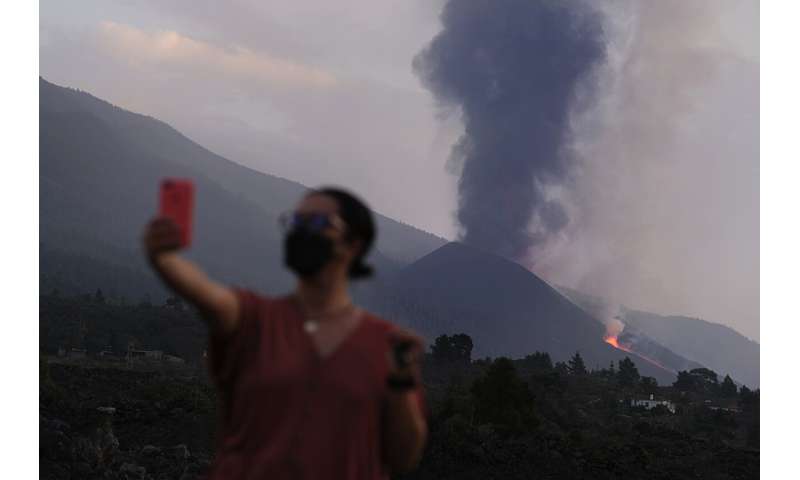

A woman takes a selfie as lava flows from a volcano on the Canary island of La Palma, Spain on Monday Sept. 27, 2021. A Spanish island volcano that has buried more than 500 buildings and displaced over 6,000 people since last week lessened its activity on Monday, although scientists warned that it was too early to declare the eruption phase finished and authorities ordered residents to stay indoors to avoid the unhealthy fumes from lava meeting sea waters. Credit: AP Photo/Daniel Roca
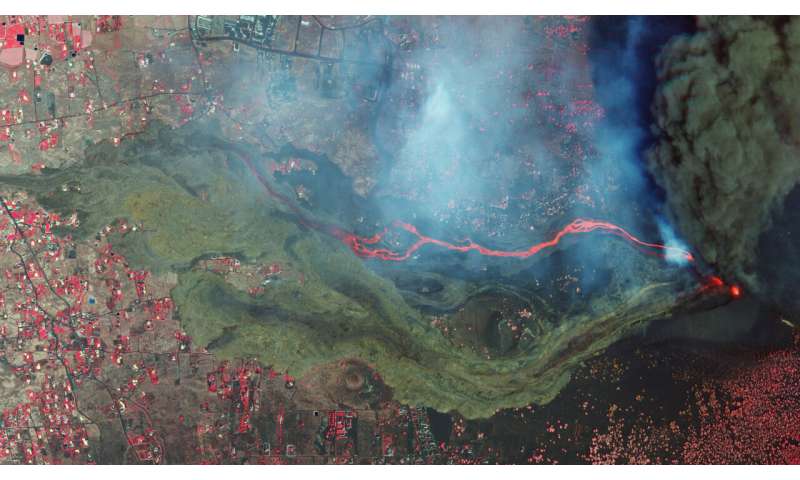

In this Sunday, Sept. 26, 2021 satellite photo from Planet Labs Inc. lava and ash from a volcano on the Canary island of La Palma, Spain can be seen. A Spanish island volcano that has buried more than 500 buildings and displaced over 6,000 people since last week lessened its activity on Monday, although scientists warned that it was too early to declare the eruption phase finished and authorities ordered residents to stay indoors to avoid the unhealthy fumes from lava meeting sea waters. Credit: Planet Labs Inc. via AP
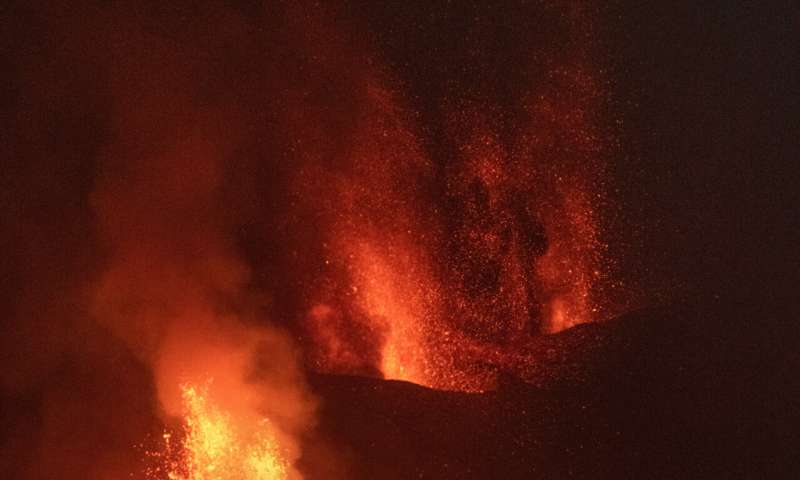

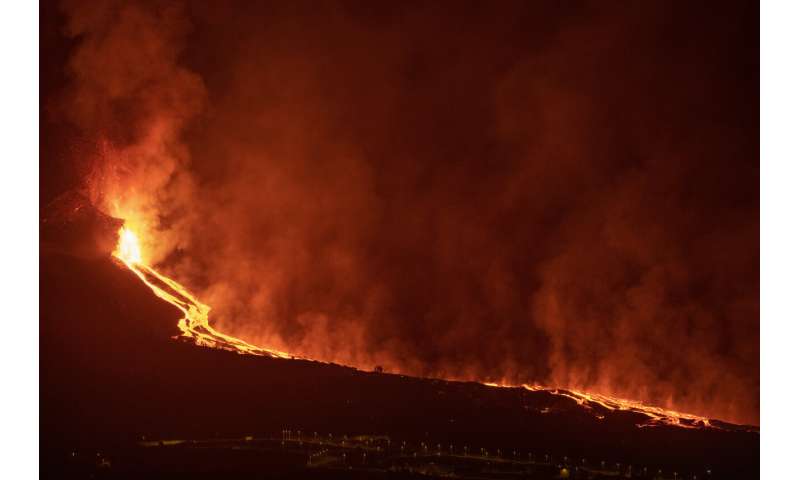
Lava flows from a volcano on the Canary island of La Palma, Spain in the early hours of Tuesday Sept. 28, 2021. A Spanish island volcano that has buried more than 500 buildings and displaced over 6,000 people since last week lessened its activity on Monday, although scientists warned that it was too early to declare the eruption phase finished and authorities ordered residents to stay indoors to avoid the unhealthy fumes from lava meeting sea waters. Credit: AP Photo/Saul Santos


Lava flows from a volcano on the Canary island of La Palma, Spain in the early hours of Tuesday Sept. 28, 2021. A Spanish island volcano that has buried more than 500 buildings and displaced over 6,000 people since last week lessened its activity on Monday, although scientists warned that it was too early to declare the eruption phase finished and authorities ordered residents to stay indoors to avoid the unhealthy fumes from lava meeting sea waters. Credit: AP Photo/Saul Santos


Lava flows from a volcano on the Canary island of La Palma, Spain in the early hours of Tuesday Sept. 28, 2021. A Spanish island volcano that has buried more than 500 buildings and displaced over 6,000 people since last week lessened its activity on Monday, although scientists warned that it was too early to declare the eruption phase finished and authorities ordered residents to stay indoors to avoid the unhealthy fumes from lava meeting sea waters. Credit: AP Photo/Saul Santos
No deaths or serious injuries have been reported, thanks to the prompt evacuations of over 6,000 people.
But local people have lost their homes and their livelihoods at the same time. Farming is one of the island's economic mainstays, along with tourism, and the lava and ash has ruined crops and irrigation systems, endangered aviation and poses a significant health risk to those nearby.
No flights went in or out of La Palma's airport for a fourth straight day because of a huge ash cloud. Volcanic ash is hazardous for aircraft engines.
The Spanish government announced after its weekly Cabinet meeting Tuesday it's providing an immediate grant of 10.5 million euros ($12.3 million) to buy 107 properties to rehouse local people and also provide them with income aid.
More aid, including for the rebuilding of public infrastructure, will be sent once the current emergency is over, government spokeswoman Isabel Rodríguez said.
The volcano has so far spewed out more than 46 million cubic meters (1.6 billion cubic feet) of molten rock, according to the Canary Island Volcanology Institute.
Explore furtherSpanish volcano still packs a punch 5 days after eruption
© 2021 The Associated Press. All rights reserved. This material may not be published, broadcast, rewritten or redistributed without permission.
No deaths or serious injuries have been reported, thanks to the prompt evacuations of over 6,000 people.
But local people have lost their homes and their livelihoods at the same time. Farming is one of the island's economic mainstays, along with tourism, and the lava and ash has ruined crops and irrigation systems, endangered aviation and poses a significant health risk to those nearby.
No flights went in or out of La Palma's airport for a fourth straight day because of a huge ash cloud. Volcanic ash is hazardous for aircraft engines.
The Spanish government announced after its weekly Cabinet meeting Tuesday it's providing an immediate grant of 10.5 million euros ($12.3 million) to buy 107 properties to rehouse local people and also provide them with income aid.
More aid, including for the rebuilding of public infrastructure, will be sent once the current emergency is over, government spokeswoman Isabel Rodríguez said.
The volcano has so far spewed out more than 46 million cubic meters (1.6 billion cubic feet) of molten rock, according to the Canary Island Volcanology Institute.
Explore furtherSpanish volcano still packs a punch 5 days after eruption
© 2021 The Associated Press. All rights reserved. This material may not be published, broadcast, rewritten or redistributed without permission.
No comments:
Post a Comment